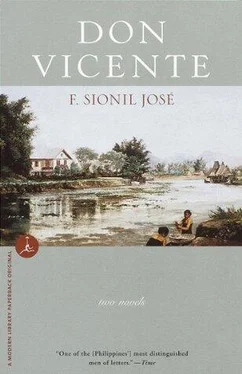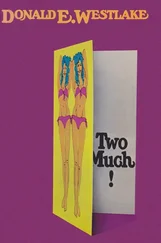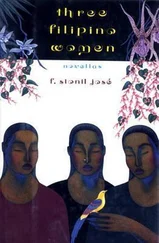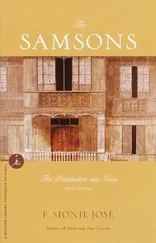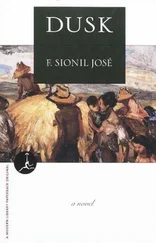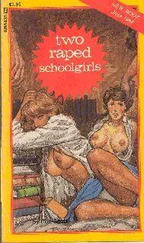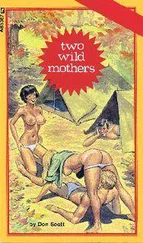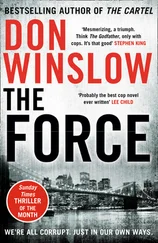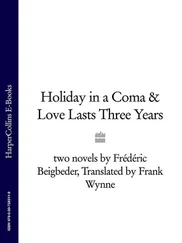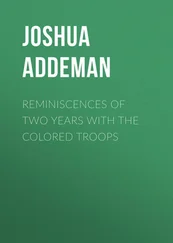He had majored in philosophy and was easily the most learned man in town, and his favorite high-sounding expression always had “aesthetics” to it — Don Vicente had no “moral aesthetics,” Father had “no aesthetics” in his life, and he worried about my becoming “an aesthete.”
He chose to return home to paint shop signs, calesas and caretelas , and, for the town fiesta, arches to the auditorium and, of course, his annual masterpiece, the stage and throne of the fiesta queen and her princesses. He could not make a living in Manila doing portraits or the still lifes and landscapes he wanted to do, so he lavished some of his talents on the mundane things in our town, and it was our calesa , its tin inlay aside, that was the most colorful, for he had covered it with cloud and floral designs, as he did with jeepneys in a much later period.
He went to Manila perhaps once a month, sometimes twice, to “unburden” himself, and I always looked forward to his return after three or four days, for he always had something for me — books, chocolates. Indeed, he was my favorite relative, and his big room on the ground floor was almost mine. It was airy, with frosted windows that were open most of the time. One side opened to the garden, and in the morning when the sun flooded the green, his room would be ablaze with light, which never seemed enough. He had Aladdin lamps without their shades, and they were almost always on so that, as he said, he should be able to see everything, even the sins that were hiding under every speck of dirt.
This was his domain, and its main difference, I think, from rooms or the sala of most houses I have been to was not its brightness. He had this diploma — a fine document from his college in a gilt frame, with silver lettering in Latin and a pompous seal. All the diplomas I had seen in our town were in living rooms, prominently displayed for everyone to see.
“Diplomas are turds,” he said, and his hung right in front of the toilet bowl in his closet.
His room, as I have said, was always open, and I often wandered in and out, poked among his things, his paints and brushes, his sketches of nudes, and heaps and heaps of old magazines, pieces of string, bits of glass, old bottles, all of which he said he would shape into living and breathing objects.
Of all his paintings, it was his portrait of Don Vicente that intrigued me most, for he had, more than with any other, enjoyed doing it. As the youngest, he always spoke to Father and all those older than him with some diffidence, but he cast aside the familial hierarchy when he spoke about Don Vicente. “It is time you end your servitude to him,” he had said. “What do you want a hacienda as big as his for? You will be getting many problems, and in the end you will not even be able to enjoy the simplest food that the farmers have.”
Father chose to ignore tirades such as these, reminding Cousin Marcelo that he did not know much about the mundane ways of the world, because as an artist he was confined to the ozone regions of the mind. It was, of course, a rebuttal that Cousin Marcelo did not accept, for he felt he was closer than most to reality, to people, and to the tune of living.
“That is what an artist is,” he said, defining himself.
One warm April afternoon, a delegation of the town’s civic leaders had come to the house seeking Father’s approval for a project that would endear them all to Don Vicente. A case of sarsaparilla, a bottle of gin, and cracked ice had enlivened the discussion, which centered on the forthcoming celebration of the town fiesta. It was Mr. Alafriz, the councilor from the market district, who suggested that, aside from crowning the fiesta queen, Don Vicente should also be honored with a statue, so that “he would look toward the town with kindlier eyes.”
In the haze of Alhambra smoke and the torpor of Fundador, Cousin Marcelo barged in and bellowed, “You will do no such thing.”
All eyes turned to him. His face visibly red with embarrassment, Father said, “Explain, Celo.”
“And who would do the statue of Don Vicente? Would you be able to get someone bright enough to chisel out all the secret recesses of his personality? Show all the different layers and folds of his fat and his character? And where will you get the mountain of marble, not just for the shape of his corpulent body but for the immensity of his greed? You will insult the memory of Rizal by building this man a monument. Images of stone can only be for beings like Mabini, Bonifacio, Rizal. For someone like Don Vicente, you need something different, something that is equal to his rapacity.”
“What are you thinking of?” Father asked.
“You don’t have to spend. And he can take it with him if he wants to.”
“Please tell us what it is,” Councilor Alafriz said.
“I will paint his portrait,” Cousin Marcelo said.
The politicians could not afford to insult Cousin Marcelo; he was Father’s brother, he was far more educated than all of them put together. There were hesitant murmurs, but in the end they agreed, convinced by the most practical of reasons — that the portrait would not cost them one centavo.
For one whole week, Cousin Marcelo labored in his room, which, for once, was locked. When Mr. Alafriz checked on him afterward, he always assured the councillor that the portrait would be finished on time. The great day came, but Don Vicente was not able to come to the fiesta; his piles had gotten worse, and he had to go through surgery. The first time I saw the portrait, I wondered why it was done the way it was — the blobs of black, the smouldering face — and to my question, Cousin Marcelo had grinned: “Just picture Don Vicente in your mind, what you feel about him, what you think he is, and there you have it.”
His second chance to be of use to the town as an artist came when Padre Andong rebuilt the church. Cousin Marcelo said he would do murals for it, to depict God as he saw Him — not a just God but a vengeful one. I suppose that if Padre Andong had lived longer, he would have acceded to Cousin Marcelo’s services.
There is something about a new church that attracts people and bids them welcome. They wander in, their eyes go over the newly painted walls, the shiny altar still flavored with the smell of mortar. Then they pray a little and make the wish, which is supposed to come true sooner or later because it was made during their first visit to the church.
I am sure that, since then, many strangers have entered the new church more in the spirit of adventure than to commune with their faith. Built of hollow blocks with a new tin roof, it adjoins a convent with hardwood panels and a brick porch.
We never had an old venerable church such as those moss-covered edifices farther north, because our church — like our town — is new. The old church had been a ramshackle building that, somehow, was not refurbished even at the time when Rosales was at the height of its prosperity as the rice-trading center of eastern Pangasinan. But it had a quiet and simple atmosphere, and any man who wanted peace could enter and never bother asking if it was Protestant, Aglipayan, or Seventh-Day Adventist.
The façade was a triangle mounted by a white cross. The churchyard was plain carabao grass, with a gravel path lined with rosal. The floor of the church was plain cement, rough and uneven in parts. A skeleton of a belfry was attached to one side of the church, and it shook every time we climbed it to toll the Angelus, the elevation of the host, or the arrival of the dead. A mango tree squatted by the belfry, and on the days that we had nothing to do, we often climbed it, roosted on its branches, and told fool stories.
Everything is changed now; the mango tree has been cut. On the days that it was laden with fruit, Padre Andong used to count them like some miser and would rail at us when he saw us eating the sour green mangoes. “Why can you not wait till they ripen?” he lamented.
Читать дальше
